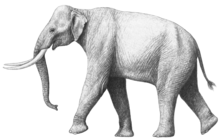
A mammoth is any species of the extinct elephantid genus Mammuthus. The various species of mammoth were commonly equipped with long, curved tusks. They lived from the late Miocene epoch into the Holocene about 4,000 years ago, and various species existed in Africa, Europe, Asia, and North America. Mammoths are more closely related to living Asian elephants than African elephants.

Proboscidea is a taxonomic order of afrotherian mammals containing one living family (Elephantidae) and several extinct families. First described by J. Illiger in 1811, it encompasses the elephants and their close relatives. Proboscideans include some of the largest known land mammals. The largest land mammal of all time may have been a proboscidean; the elephant Palaeoloxodon namadicus has been estimated to be up to 5.2 m (17.1 ft) at the shoulder and may have weighed up to 22 t, surpassing the paraceratheres, the otherwise largest known land mammals, though this estimate was made based on a single fragmentary femur and is speculative. The largest extant proboscidean is the African bush elephant, with a record of size of 4 m (13.1 ft) at the shoulder and 10.4 t. In addition to their enormous size, later proboscideans are distinguished by tusks and long, muscular trunks, which were less developed or absent in early proboscideans.

A mastodon is a member of the genus Mammut, which strictly defined, was endemic to North America and lived from the late Miocene to the early Holocene. Mastodons belong to the order Proboscidea, the same order as elephants and mammoths. Mammut is the type genus of the extinct family Mammutidae, which diverged from the ancestors of modern elephants at least 25 million years ago, during the Oligocene.
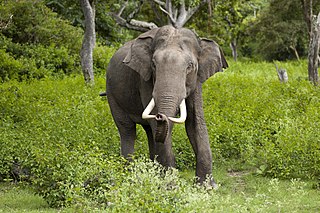
Elephantidae is a family of large, herbivorous proboscidean mammals collectively called elephants and mammoths. These are large terrestrial mammals with a snout modified into a trunk and teeth modified into tusks. Most genera and species in the family are extinct. Only two genera, Loxodonta and Elephas, are living.
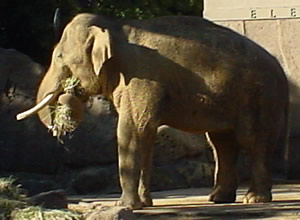
Elephas is one of two surviving genera in the family of elephants, Elephantidae, with one surviving species, the Asian elephant, Elephas maximus. Several extinct species have been identified as belonging to the genus, extending back to the Pliocene era.
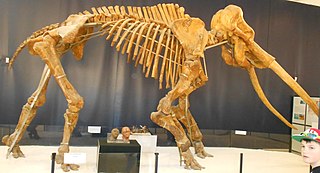
Palaeoloxodon is an extinct genus of elephant. The genus originated in Africa during the Early Pleistocene, and expanded into Eurasia at the beginning of the Middle Pleistocene. The genus contains some of the largest known species of elephants, over 4 metres (13 ft) tall at the shoulders, including the African Palaeoloxodon recki, the European straight-tusked elephant and the South Asian Palaeoloxodon namadicus. P. namadicus has been suggested to be the largest known land mammal by some authors based on extrapolation from fragmentary remains, though these estimates are highly speculative. In contrast, the genus also contains many species of dwarf elephants that evolved via insular dwarfism on islands in the Mediterranean, some only 1 metre (3.3 ft) in height, making them the smallest elephants known. The genus has a long and complex taxonomic history, and at various times, it has been considered to belong to Loxodonta or Elephas, but today is usually considered a valid and separate genus in its own right.

Dwarf elephants are prehistoric members of the order Proboscidea which, through the process of allopatric speciation on islands, evolved much smaller body sizes in comparison with their immediate ancestors. Dwarf elephants are an example of insular dwarfism, the phenomenon whereby large terrestrial vertebrates that colonize islands evolve dwarf forms, a phenomenon attributed to adaptation to resource-poor environments and lack of predation and competition.

The straight-tusked elephant is an extinct species of elephant that inhabited Europe and Western Asia during the Middle and Late Pleistocene. It was larger than any living elephant, with adult males suggested to reach 3.81–4.2 metres (12.5–13.8 ft) in shoulder height, and 11.3–15 tonnes in weight. Like modern elephants, the straight-tusked elephant lived in herds, flourishing during interglacial periods, when its range would extend as far north as Great Britain. Skeletons found in association with stone tools and wooden spears suggest they were scavenged and hunted by early humans, including Neanderthals. It is the ancestral species of most dwarf elephants that inhabited islands in the Mediterranean.

Palaeoloxodon falconeri is an extinct species of dwarf elephant from the Middle Pleistocene of Sicily and Malta. It is amongst the smallest of all dwarf elephants at only 1 metre (3.3 ft) in height. A member of the genus Palaeoloxodon, it derived from a population of the mainland European straight-tusked elephant.

Mammuthus meridionalis, sometimes called the southern mammoth, is an extinct species of mammoth native to Eurasia, including Europe, during the Early Pleistocene, living from around 2.5 million years ago to 800,000 years ago.

Mammuthus trogontherii, sometimes called the steppe mammoth, is an extinct species of mammoth that ranged over most of northern Eurasia during the Early and Middle Pleistocene, approximately 1.7 million-200,000 years ago. One of the largest mammoth species, it evolved in East Asia during the Early Pleistocene, around 1.8 million years ago, before migrating into North America around 1.5 million years ago, and into Europe during the Early/Middle Pleistocene transition, around 1 to 0.7 million years ago. It was the ancestor of the woolly mammoth and Columbian mammoth of the later Pleistocene.

Sinomastodon is an extinct gomphothere genus known from the Late Miocene to Early Pleistocene of Asia, including China, Japan, Thailand, Myanmar, Indonesia and probably Kashmir.
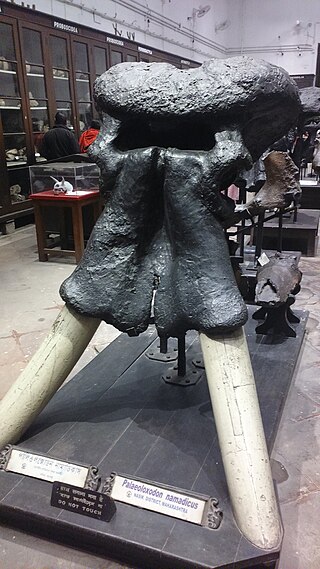
Palaeoloxodon namadicus is an extinct species of prehistoric elephant known from the early Middle to Late Pleistocene of the Indian subcontinent, and possibly also elsewhere in Asia. The species grew larger than any living elephant, and some authors have suggested it to have been the largest known land mammal based on extrapolation from fragmentary remains, though these estimates are speculative.

Palaeoloxodon cypriotes is an extinct species of dwarf elephant that inhabited the island of Cyprus during the Late Pleistocene. Remains comprise 44 molars, found in the north of the island, seven molars discovered in the south-east, a single measurable femur and a single tusk among very sparse additional bone and tusk fragments. The molars support derivation from the large straight-tusked elephant (Palaeoloxodon antiquus). The species is presumably derived from the older, larger P. xylophagou from the late Middle Pleistocene which reached the island presumably during a Pleistocene glacial maximum when low sea levels allowed a low probability sea crossing between Cyprus and Asia Minor. During subsequent periods of isolation the population adapted within the evolutionary mechanisms of insular dwarfism, which the available sequence of molar fossils confirms to a certain extent. The fully developed Palaeoloxodon cypriotes weighed not more than 200 kg (440 lb) and had a height of around 1 m (3.28 ft). The species became extinct around 12,000 years ago, around the time humans first colonised Cyprus.

Palaeoloxodon mnaidriensis is an extinct species of dwarf elephant belonging to the genus Palaeoloxodon, native to the Siculo-Maltese archipelago during the late Middle Pleistocene and Late Pleistocene. It is derived from the European mainland straight-tusked elephant.
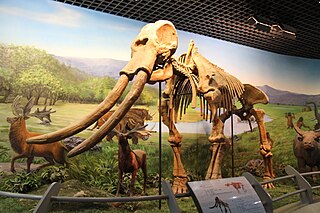
Palaeoloxodon naumanni, occasionally called Naumann's elephant, is an extinct species belonging to the genus Palaeoloxodon found in the Japanese archipelago during the Middle to Late Pleistocene around 330,000 to 24,000 years ago. It is named after Heinrich Edmund Naumann who discovered the first fossils at Yokosuka, Kanagawa, Japan. Fossils attributed to P. naumanni are also known from China and Korea, though the status of these specimens is unresolved, and some authors regard them as belonging to separate species.
Palaeoloxodonjolensis is an extinct species of elephant. The type specimen is located in the National Museum of Natural History in Paris. It is either considered the descendant species or last evolutionary stage of Palaeoloxodon recki in Africa. It is only known from isolated molars. The species is known from remains found across Africa, which are largely poorly dated to approximately the late Middle Pleistocene to Late Pleistocene, with some authors suggesting an exclusively late Middle Pleistocene age, as the only well dated specimens of the species are over 130,000 years old. Like P. recki, they are thought to have been dedicated grazers, being distinguished from earlier P. recki by having increased hypsodonty and enamel folding, with the plates being thicker along the long axis of the tooth. Following the extinction of the species, it was largely replaced by the modern African bush elephant.

Elephas planifrons is an extinct species of elephant, known from the Late Pliocene-Early Pleistocene of the Indian subcontinent.
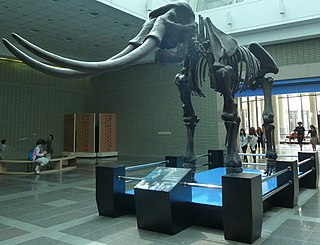
Palaeoloxodon huaihoensis is an extinct species of elephant belonging to the genus Palaeoloxodon known from the Pleistocene of China. It was first named a subspecies of P. naumanni by J. Liu in 1977 based on a partial skeleton from Huaiyuan, Anhui, and was later elevated to species rank by G. Qi in 1999, who also included remains found in the Penghu Channel between the Penghu archipelago and Taiwan. The Penghu Channel remains are suggested to date to the Middle and Late Pleistocene. A mostly complete adult skull from Late Pleistoene Nihewan basin in Hebei may be referrable to this species. The body size is very large, comparable to Indian Palaeoloxodon namadicus and the European straight-tusked elephant. In comparison to Indian P. namadicus, the postcranial skeleton is substantially more robust, and greatly resembles that of P. antiquus. The morphology of IVPP V4443 is also overall more similar to that of P. antiquus than P. namadicus, but the parietal-occipital crest at the top of the skull displays a very robust morphology closer to that of P. namadicus. The oldest remains of Palaeoloxodon in North China date to the early Middle Pleistocene, around 700,000 years ago. The latest dates for Palaeoloxodon in China are from the Late Pleistocene, and a Holocene survival is not substantiated. Mitochondrial genomes retrieved from Chinese Palaeoloxodon individuals from North China reveal that like the European P. antiquus, they harboured mitochondrial lineages derived from those of African forest elephants as a result of hybridisation with that species prior to Palaeoloxodon leaving Africa.

Phanagoroloxodon is an extinct genus of elephant. It is known from one species Phanagoroloxodon mammontoides described from a partial skull found on the banks of the Psekups river in the northwestern Caucasus of Russia, of probable Late Pliocene-Early Pleistocene age. Phanagoroloxodon has been suggested to share a close common ancestry with Elephas, as well as mammoths, combining characteristics of both genera. Like the Asian elephant, the top of the skull has a groove running along the midline, while the tusks are suggested to be twisted, similar to those of mammoths. A 2020 PhD thesis by Steven Zhang suggested that Elephas recki brumpti from the Pliocene of East Africa should be subsumed into the species Elephas planifrons, known from the Late Pliocene-Early Pleistocene of the Indian subcontinent, and that this species should be placed as a second species of Phanagoroloxodon. However, these suggestions were rejected by Sanders (2023).

